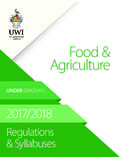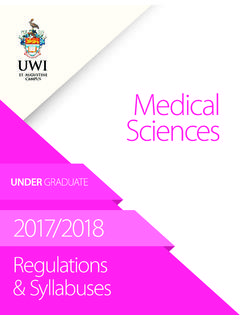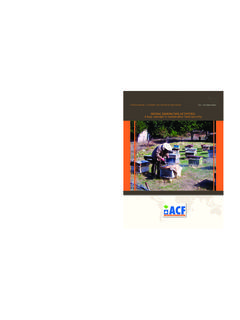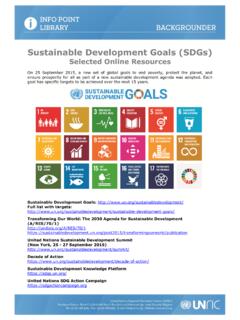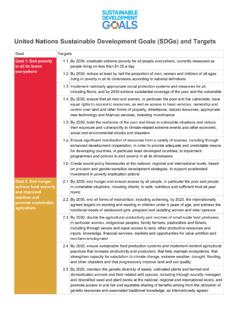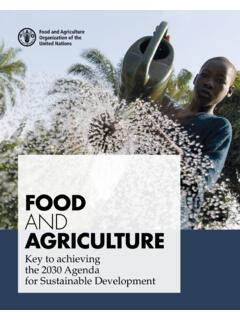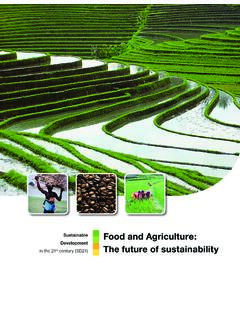Transcription of Indigenous Knowledge and Sustainable Development
1 Indigenous Knowledge and Sustainable Development Mervyn Claxton Third Dation istingushed Lecture, The Cropper FoundUWI, St Aud Tobago gustine, Trinidad anSeptember 1, 2010 Page | 1 Biodiversity, Indigenous Knowledge , and Sustainable Development are very closely linked. The Indigenous Knowledge systems of the peoples of the South constitute the world largest reservoir of knowledege of the diverse species of plant and animal life on earth. For many centuries, their Indigenous agricultural systems have utilized practices and techniques which embody, what one scientist has called Principles of Permanence - principles that permit continuous cropping all year around without the use of chemicals which degrade the environment.
2 Furthermore, not only do they not deplete the earth s natural resources but they often replenish them. Ecological agriculture, organic agriculture, and conservation agriculture are the names employed by modern science to describe the methods, techniques, and practices which the Indigenous peoples of the South have applied for many centuries. Ecological agriculture, or to use its original name, Indigenous agricultural Knowledge , is recognized by a growing number of scientists as the most effective method of promoting Sustainable Development . A new term should be coined to give recognition to that important, but little known, fact.
3 I would suggest the term eco- Indigenous Knowledge - one that I propose to use throughout this evening s address. 1 Industry, conventional agriculture, deforestation and transport are the four major sources of greenhouse gases which contribute to climate change. Page | 2 The International Panel for Climate Change (IPCC) has proposed Carbon Capture and Storage (CCS) as an effective method of removing carbon gases from the atmosphere, a proposal adopted by the Copenhagen Conference. However, recent research findings show that ecological agriculture sequesters carbon from the atmosphere more cheaply and more effectively than CCS.
4 Thus, eco- Indigenous Knowledge should possibly be considered the essential factor in solutions for the problems of preserving biodiversity, promoting Sustainable Development , and mitigating climate change. Those three problems, arguably, constitute the most important challenges that confront mankind today. The term Indigenous means local or native to the country, the people or the society concerned. However, shortly after the beginning of the European colonial adventure, that term gradually assumed a derogatory connotation. In the course of time, it came to be applied exclusively to non-European peoples, who were, and to some extent, still are considered inferior to those of the North.
5 That distorted usage of the term has been so systematic and persistent that most peoples in the South subconsciously came to associate Indigenous with inferior . Regrettably, that insidious association appears to have influenced our attitudes, our life styles and, more importantly, our choice of Development techniques, policies, models, and strategies. The assimilation of the Indigenous to the inferior influenced and possibly still does, our choice of Development experts and expertise. In the early 1980s, Unesco was chosen to be the Executing Agency for the technical 2 assistance component of a large Development loan project in a Caricom country.
6 Normally, the executing agency would submit, for the government s approval, a prioritised list of three or four experts for each project post. I was involved with that project in a coordinating role and, in that capacity, I received a list of countries from which the government wanted the experts to be selected. Perhaps, because they were considered Indigenous and, perforce, inferior none was from the Global South, although Unesco s roster of experts contained excellent African and Indian experts whose experence might have been more relevant than those eventually chosen. Instead of choosing experts on their merit, the Caricom country in question decided instead to choose countries on their perceived merit.
7 Page | 3 Whether we like it or not, peoples of the South are all Indigenous in the eyes of peoples in the North. We can continue to shy away from the use of that term, because we have integrated, into our personalities, its derogatory connotation. Or, we can appropriate it, wear it like a badge of honour and, by so doing, rob it of its derogatory connotation and, thus, restore to the term to its original neutral meaning. That is what French impressionist painters did in the late 19th century. The term, Impressionism , was coined by a conservative French critic, Louis Leroy, who used it in a satric review of Claude Monet s painting Impression, soleil levant ( Impression, Sunrise ), after seeing it at an art exhibition in 1874.
8 Instead of shying away from the term, as we have done, and still do, with Indigenous , the impressionists appropriated it. They wore it like a badge of honour, which soon robbed the term of its derogatory connotation. Indeed, the term has come to represent the best in modern art. The paintings of the Impressionists are currently the most sought after, and the most expensive in the international art market. 3 When we shall have rid ourselves of the stigma of the Indigenous , then and only then, will we possess the cultural confidence to deal with the North on the basis of its real merits (and demerits) and not on its perceived merits, and on our terms, not on theirs.
9 Only then will we be prepared to consider our Indigenous cultures a Development resource rather than a Development obstacle and, also, the best possible source of solutions for problems of Sustainable Development . With that newly-won confidence, we would also be ready to borrow and exchange eco- Indigenous Knowledge , with Development potential, with other countries in the Global South. Page | 4 The vast majority of plant and animal species are to be found in the world s tropical zones. Tropical America accounts for over half of the estimated closed tropical forest in the world, with Brazil being the single richest country in overall species diversity.
10 The second richest is Colombia, home to some ten per cent of all species of terrestrial plants and animals. According to one estimate, there are some 120,000 different species of plant life in Brazil alone, many of which the Indigenous inhabitants have utilised, from time immemorial for medicinal and other purposes. Their eco- Indigenous Knowledge of the medicinal properties of the region s flora was considered so very valuable that a scientific expedition was sent from Europe, in 1630, to make a methodical description of the plants which the Indigenous peoples of Brazil utilised for that very purpose. That Indigenous Knowledge was, apparently, so considerable that the scientists took twenty-four years to collect and catalogue it.
